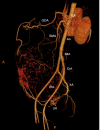Abdominopelvic leiomyoma with large ascites: A case report and review of the literature
- PMID: 33644211
- PMCID: PMC7896699
- DOI: 10.12998/wjcc.v9.i6.1424
Abdominopelvic leiomyoma with large ascites: A case report and review of the literature
Abstract
Background: Leiomyoma of the uterus is relatively common, but uterine leiomyoma of the greater omentum is rare.
Case summary: Here, we report the case of a 22-year-old woman who presented with a 3 mo history of progressive abdominal distension and a hypervascular abdominopelvic mass. Due to a high serum concentration of CA125, the preoperative diagnosis was unclear. During surgery, 5 L of ascites was removed. An 18.8 cm solid mass, which was pedunculated from the uterine fundus and exhibited complex adhesion to the greater omentum, was removed. The CA125 level was reduced postoperatively, and a pathologic study confirmed that the mass was a leiomyoma that originated in the uterus.
Conclusion: Uterine leiomyoma can share vessels with the greater omentum. This case highlights the difficulty of diagnosing pseudo-Meigs syndrome and the importance of imaging and laboratory examinations.
Keywords: Ascites; CA125; Case report; Greater omentum; Leiomyoma; Pseudo-Meigs syndrome.
©The Author(s) 2021. Published by Baishideng Publishing Group Inc. All rights reserved.
Conflict of interest statement
Conflict-of-interest statement: The authors declare that they have no conflict of interest to report.
Figures




Similar articles
-
Pseudo-Meigs syndrome caused by a rapidly enlarging hydropic leiomyoma with elevated CA125 levels mimicking ovarian malignancy: a case report and literature review.BMC Womens Health. 2024 Aug 7;24(1):445. doi: 10.1186/s12905-024-03285-8. BMC Womens Health. 2024. PMID: 39112955 Free PMC article. Review.
-
Pseudo-Meigs Syndrome Caused by a Giant Uterine Leiomyoma with Cystic Degeneration: A Case Report.J Nippon Med Sch. 2020 May 15;87(2):80-86. doi: 10.1272/jnms.JNMS.2020_87-205. Epub 2019 Dec 27. J Nippon Med Sch. 2020. PMID: 31902853
-
Pseudo-meigs syndrome: uterine leiomyoma with bladder attachment associated with ascites and hydrothorax - a rare case of a rare syndrome.Onkologie. 2002 Oct;25(5):443-6. doi: 10.1159/000067439. Onkologie. 2002. PMID: 12415199 Review.
-
Ascites in puerperium: a rare case of atypical pseudo-Meigs' syndrome complicating the puerperium.Arch Gynecol Obstet. 2009 Dec;280(6):1033-7. doi: 10.1007/s00404-009-1041-0. Epub 2009 Mar 26. Arch Gynecol Obstet. 2009. PMID: 19322576
-
Concentrated ascites re-infusion therapy for pseudo-Meigs' syndrome complicated by massive ascites in large pedunculated uterine leiomyoma.J Obstet Gynaecol Res. 2014 Jul;40(7):1944-9. doi: 10.1111/jog.12448. J Obstet Gynaecol Res. 2014. PMID: 25056475
Cited by
-
Pseudo-Meigs syndrome caused by a rapidly enlarging hydropic leiomyoma with elevated CA125 levels mimicking ovarian malignancy: a case report and literature review.BMC Womens Health. 2024 Aug 7;24(1):445. doi: 10.1186/s12905-024-03285-8. BMC Womens Health. 2024. PMID: 39112955 Free PMC article. Review.
References
-
- Quade BJ, Wang TY, Sornberger K, Dal Cin P, Mutter GL, Morton CC. Molecular pathogenesis of uterine smooth muscle tumors from transcriptional profiling. Genes Chromosomes Cancer. 2004;40:97–108. - PubMed
-
- Skubitz KM, Skubitz AP. Differential gene expression in leiomyosarcoma. Cancer. 2003;98:1029–1038. - PubMed
Publication types
LinkOut - more resources
Full Text Sources
Other Literature Sources
Research Materials
Miscellaneous

